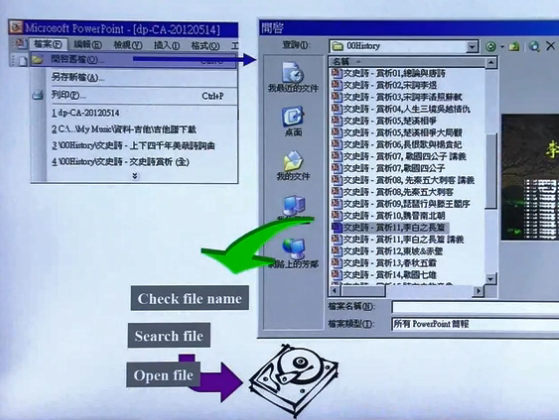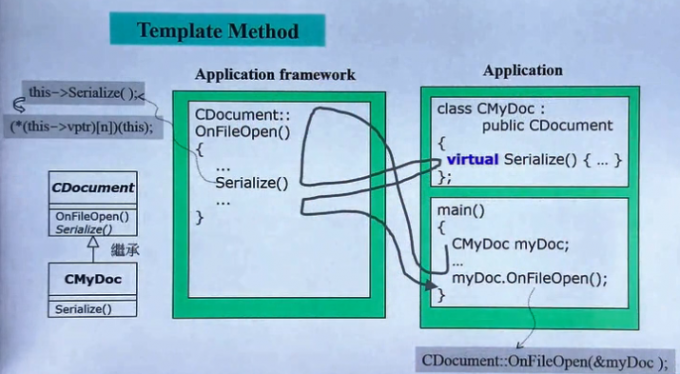Caffe原始碼理解3:Layer基類與template method設計模式
目錄
部落格:blog.shinelee.me | 部落格園 | CSDN
寫在前面
層的概念在深度神經網路中佔據核心位置,給定輸入,資料在層間運算流動,最終輸出結果。層定義了對資料如何操作,根據操作的不同,可以對層進行劃分(具體參見Caffe Layers):
- Data Layers:跟據檔案型別和格式讀取和處理資料,給網路輸入
- Vision Layers:輸入特徵圖輸出也是特徵圖,像卷積、池化等
- Activation Layers:定義了逐元素的操作,輸入輸出shape相同,像ReLU、sigmoid等,
- Loss Layers:比較網路最終輸出與目標的偏差,以縮小偏差為目的來驅動網路向目標學習,像Softmax with Loss等
- Common Layers:全連線層、dropout等
- Normalization Layers:歸一化層,像LRN、MVN、BN等
- Utility Layers:特殊功能的層,像split、slice、concat等
注意,在Caffe中啟用是單獨的層,損失也是單獨的層。所有這些層,都從一個共同的基類Layer
Layer定義了這些類共有的行為和資料部分,這篇文章的重點就是介紹這個基類。
Layer採用了template method設計模式,因此先介紹template method。
template method設計模式
template method設計模式,即在父類中定義好流程的框架,而流程中的某些步驟在子類中具體實現。下面以開啟檔案為例(例子來自侯捷老師),所有客戶端軟體開啟檔案的流程都是類似的,如下圖所示,這個流程可以事先定義好,寫在SDK裡,但是,將來這個SDK要被用來開啟什麼型別的檔案是SDK的設計者無法完全預測的,因此具體某個型別的檔案該如何讀取應由SDK的使用者來編寫。

那麼,SDK設計者定義的流程如何在執行到檔案讀取步驟時使用“將來”SDK使用者編寫的程式?這就需要SDK的設計者將這個步驟設計為虛擬函式(關於虛擬函式可以檢視cppreference.com),將來SDK的使用者繼承這個類同時重寫對應的虛擬函式,這種實現方法就是template method設計模式,其呼叫順序如下圖所示。

caffe中的基類Layer在設計時就採用了這種思想。
Layer 基類
Layer成員變數
先看一下Layer的成員變數,具體參看註釋。
LayerParameter layer_param_; // 將protobuf中定義的該層的超引數等物件化儲存
Phase phase_; // TRAIN or TEST,指示該層參與訓練還是測試
vector<shared_ptr<Blob<Dtype> > > blobs_; // 儲存可學習引數(權重)param blob
vector<bool> param_propagate_down_; // 指示每個param blob是否需要計算diff
vector<Dtype> loss_; // 儲存top blob在損失函式中的權重loss_weight(與top blob數量相同),在反向傳播時會作用在梯度上
// 對於損失層loss_weight預設為1(見LossLayer的LayerSetUp),其他層預設對損失函式沒有直接貢獻層所擁有的是它的可學習引數部分,輸入輸出都不屬於層,因此輸入輸出blob並不是層的成員變數,而只出現在介面上,層關注的是對資料的操作方式本身,這是設計時的考量。
構造與析構
構造與析構,Layer的子類不需要實現自己的建構函式,所有的set up操作應該在後面的SetUp函式中完成,建構函式中僅將納入LayerParameter、設定pahse_以及寫入初始網路權重(如果在protobuf檔案中指定了的話)。
explicit Layer(const LayerParameter& param)
: layer_param_(param) {
// Set phase and copy blobs (if there are any).
phase_ = param.phase();
if (layer_param_.blobs_size() > 0) {
blobs_.resize(layer_param_.blobs_size());
for (int i = 0; i < layer_param_.blobs_size(); ++i) {
blobs_[i].reset(new Blob<Dtype>());
blobs_[i]->FromProto(layer_param_.blobs(i));
}
}
}
virtual ~Layer() {}SetUp成員函式
SetUp是本文最為關注的成員函式,顧名思義,其負責完成層的基礎搭建工作。在Net初始化時會順序呼叫每個層的SetUp函式來搭建網路,見Net::Init,Net::Init利用多型+template method在一個迴圈中完成所有層的搭建。
// in Net::Init
for (int layer_id = 0; layer_id < param.layer_size(); ++layer_id) {
// ……
// After this layer is connected, set it up.
layers_[layer_id]->SetUp(bottom_vecs_[layer_id], top_vecs_[layer_id]);
// ……
}
// in net.hpp
/// @brief Individual layers in the net
vector<shared_ptr<Layer<Dtype> > > layers_;SetUp在設計時就採用了template method設計思想,基類Layer為所有派生類的SetUp定義好了流程框架,先檢查bottom和top的blob數量是否正確,然後呼叫LayerSetUp為完成層“個性化”的搭建工作(如卷積層會設定pad、stride等引數),再根據層自己定義的操作以及bottom的shape去計算top的shape,最後根據loss_weight設定top blob在損失函式中的權重。其中,Reshape為純虛擬函式,子類必須自己實現,CheckBlobCounts和LayerSetUp為虛擬函式,提供了預設實現,子類也可以定義自己的實現。一般,SetUp的執行順序為:
- 進入父類的
SetUp函式 - 執行父類的
CheckBlobCounts,在這個函式中會執行子類的ExactNumBottomBlobs等函式 - 執行子類的
LayerSetUp - 執行子類的
Reshape - 執行父類的
SetLossWeights - 退出父類的
SetUp函式
void SetUp(const vector<Blob<Dtype>*>& bottom,
const vector<Blob<Dtype>*>& top) {
CheckBlobCounts(bottom, top);
LayerSetUp(bottom, top);
Reshape(bottom, top);
SetLossWeights(top);
}
virtual void CheckBlobCounts(const vector<Blob<Dtype>*>& bottom,
const vector<Blob<Dtype>*>& top) {
// 實現具體省略
/* check that the number of bottom and top Blobs provided as input
match the expected numbers specified
by the {ExactNum,Min,Max}{Bottom,Top}Blobs() functions
*/
}
/* This method should do one-time layer specific setup. This includes reading
* and processing relevent parameters from the <code>layer_param_</code>.
* Setting up the shapes of top blobs and internal buffers should be done in
* <code>Reshape</code>, which will be called before the forward pass to
* adjust the top blob sizes.
*/
virtual void LayerSetUp(const vector<Blob<Dtype>*>& bottom,
const vector<Blob<Dtype>*>& top) {}
/* This method should reshape top blobs as needed according to the shapes
* of the bottom (input) blobs, as well as reshaping any internal buffers
* and making any other necessary adjustments so that the layer can
* accommodate the bottom blobs.
*/
virtual void Reshape(const vector<Blob<Dtype>*>& bottom,
const vector<Blob<Dtype>*>& top) = 0;
/**
* Called by SetUp to initialize the weights associated with any top blobs in
* the loss function. Store non-zero loss weights in the diff blob.
*/
inline void SetLossWeights(const vector<Blob<Dtype>*>& top) {
const int num_loss_weights = layer_param_.loss_weight_size();
if (num_loss_weights) {
CHECK_EQ(top.size(), num_loss_weights) << "loss_weight must be "
"unspecified or specified once per top blob.";
for (int top_id = 0; top_id < top.size(); ++top_id) {
const Dtype loss_weight = layer_param_.loss_weight(top_id);
if (loss_weight == Dtype(0)) { continue; }
this->set_loss(top_id, loss_weight);
const int count = top[top_id]->count();
Dtype* loss_multiplier = top[top_id]->mutable_cpu_diff();
caffe_set(count, loss_weight, loss_multiplier);
}
}
}Layer在設計之初無法料想到今天會有如此多各種各樣的層,但是這些層只需要繼承基類Layer,同時定義好各自個性化的LayerSetUp和Reshape等函式,就可以將自己納入到SetUp的搭建流程,並通過Net::Init進一步納入整個網路的搭建中。
前向傳播與反向傳播
Layer為所有層定義了前向傳播與反向傳播的通用介面Forward和Backward,實際上,Forward和Backward是Forward_cpu、Forward_gpu和Backward_cpu、Backward_gpu的包裝器,子類需要定義自己的Forward_cpu、Forward_gpu和Backward_cpu、Backward_gpu,比如,卷積層前向傳播要通過卷積操作,池化層前向傳播時要通過池化操作,而不需要重寫Forward和Backward。此外,如果子類不定義自己的gpu函式,預設的gpu函式實際呼叫的是cpu函式,如下面程式碼所示,所以如果要使用GPU,必須要自己實現Forward_gpu和Backward_gpu。
public:
inline Dtype Forward(const vector<Blob<Dtype>*>& bottom,
const vector<Blob<Dtype>*>& top);
inline void Backward(const vector<Blob<Dtype>*>& top,
const vector<bool>& propagate_down,
const vector<Blob<Dtype>*>& bottom);
protected:
virtual void Forward_cpu(const vector<Blob<Dtype>*>& bottom,
const vector<Blob<Dtype>*>& top) = 0;
virtual void Forward_gpu(const vector<Blob<Dtype>*>& bottom,
const vector<Blob<Dtype>*>& top) {
// LOG(WARNING) << "Using CPU code as backup.";
return Forward_cpu(bottom, top);
}
virtual void Backward_cpu(const vector<Blob<Dtype>*>& top,
const vector<bool>& propagate_down,
const vector<Blob<Dtype>*>& bottom) = 0;
virtual void Backward_gpu(const vector<Blob<Dtype>*>& top,
const vector<bool>& propagate_down,
const vector<Blob<Dtype>*>& bottom) {
// LOG(WARNING) << "Using CPU code as backup.";
Backward_cpu(top, propagate_down, bottom);
}在下面程式碼中,注意Forward中的loss_weight的來源以及損失的計算。
template <typename Dtype>
inline Dtype Layer<Dtype>::Forward(const vector<Blob<Dtype>*>& bottom,
const vector<Blob<Dtype>*>& top) {
Dtype loss = 0;
Reshape(bottom, top);
switch (Caffe::mode()) {
case Caffe::CPU:
Forward_cpu(bottom, top);
for (int top_id = 0; top_id < top.size(); ++top_id) {
if (!this->loss(top_id)) { continue; }
const int count = top[top_id]->count();
const Dtype* data = top[top_id]->cpu_data();
const Dtype* loss_weights = top[top_id]->cpu_diff(); // 在損失函式中的權重
loss += caffe_cpu_dot(count, data, loss_weights);
}
break;
case Caffe::GPU:
Forward_gpu(bottom, top);
#ifndef CPU_ONLY
for (int top_id = 0; top_id < top.size(); ++top_id) {
if (!this->loss(top_id)) { continue; }
const int count = top[top_id]->count();
const Dtype* data = top[top_id]->gpu_data();
const Dtype* loss_weights = top[top_id]->gpu_diff();
Dtype blob_loss = 0;
caffe_gpu_dot(count, data, loss_weights, &blob_loss);
loss += blob_loss;
}
#endif
break;
default:
LOG(FATAL) << "Unknown caffe mode.";
}
return loss;
}
template <typename Dtype>
inline void Layer<Dtype>::Backward(const vector<Blob<Dtype>*>& top,
const vector<bool>& propagate_down,
const vector<Blob<Dtype>*>& bottom) {
switch (Caffe::mode()) {
case Caffe::CPU:
Backward_cpu(top, propagate_down, bottom);
break;
case Caffe::GPU:
Backward_gpu(top, propagate_down, bottom);
break;
default:
LOG(FATAL) << "Unknown caffe mode.";
}
}其他成員函式
首先是成員變數的set和get函式:
virtual inline const char* type() const { return ""; } // return the layer type
inline void SetPhase(Phase p) { phase_ = p;}
vector<shared_ptr<Blob<Dtype> > >& blobs() { return blobs_;}
vector<Blob<Dtype>*> GetBlobs();
void SetBlobs(const vector<Blob<Dtype>*>& weights);
inline Dtype loss(const int top_index) const;
inline void set_loss(const int top_index, const Dtype value);
const LayerParameter& layer_param() const { return layer_param_; }
inline bool param_propagate_down(const int param_id);
inline void set_param_propagate_down(const int param_id, const bool value);ToProto將該層的引數設定以及學習到的權重序列化輸出。
// Serialize LayerParameter to protocol buffer
template <typename Dtype>
void Layer<Dtype>::ToProto(LayerParameter* param, bool write_diff) {
param->Clear();
param->CopyFrom(layer_param_);
param->clear_blobs();
for (int i = 0; i < blobs_.size(); ++i) {
blobs_[i]->ToProto(param->add_blobs(), write_diff);
}
}下面為供CheckBlobCounts使用的函式,根據層的需要自行定義,預設狀態對top和bottom的blob數量不做要求。可見,其實CheckBlobCounts也採用了template method設計思想,只是這個函式沒那麼重要,按下不表。
virtual inline int ExactNumBottomBlobs() const { return -1; }
virtual inline int MinBottomBlobs() const { return -1; }
virtual inline int MaxBottomBlobs() const { return -1; }
virtual inline int MaxBottomBlobs() const { return -1; }
virtual inline int ExactNumTopBlobs() const { return -1; }
virtual inline int MinTopBlobs() const { return -1; }
virtual inline int MaxTopBlobs() const { return -1; }
virtual inline bool EqualNumBottomTopBlobs() const { return false; }其他成員函式
/* If this method returns true, Net::Init will create enough "anonymous" top
* blobs to fulfill the requirement specified by ExactNumTopBlobs() or
* MinTopBlobs().
*/
virtual inline bool AutoTopBlobs() const { return false; }
/* If AllowForceBackward(i) == false, we will ignore the force_backward
* setting and backpropagate to blob i only if it needs gradient information
* (as is done when force_backward == false).
*/
virtual inline bool AllowForceBackward(const int bottom_index) const {
return true;
}以上。
